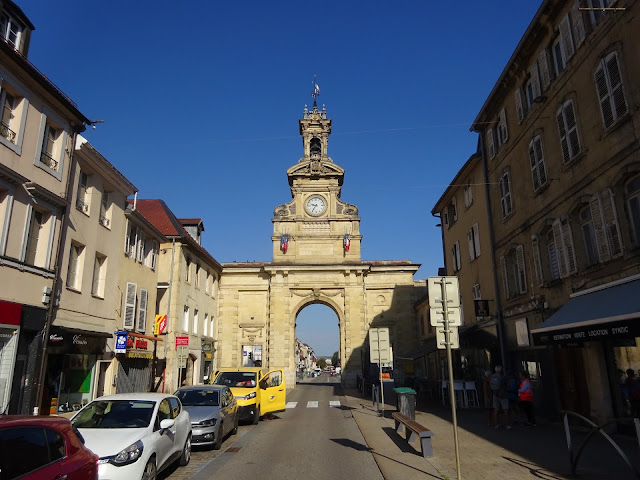I'm cycling up through the Jura Mountains and come upon this splendid white marble World War 1 memorial in a small "mom & pop" ski village. I've traveled quite a bit through France and from the biggest cities to the smallest villages there will inevitably be a World War 1 and World War 11 memorial. Does the woman look familiar? Of course you know our Statue of Liberty was a gift from the French.
Nothing special about Pontarlier (population 20,000) though it does get to brag about being the second highest town in France. It gets pretty darn cold in the winter and the area is known as the Siberia of France.
I took this picture in Pontarlier for two reasons. The chapel up on the hill and the entrance to a large Nestle factory. Cycling past I could smell chocolate. It turns out this is where Nesquik is manufactured. Nesquik is chocolate syrup as well as chocolate powder you mix with milk.
Perched atop a steep and rocky hill about two miles from Pontarlier stands Fort de Joux. Since the 1400's this fortress has been guarding the narrow passage--an important trading route from Italy to the rest of Europe. Back in 1813 the Austrians attacked and after being besieged for 21 days the castle surrendered. Why? The Austrians revealed a serious weakness in the fort's defenses. See Fort Larmont higher up to the right on the other side of the narrow passageway? That wasn't there back in 1813 and the Austrians lugged artillery up there and proceeded to fire down on Fort de Joux.
Making my way up the road.
Here's the entrance.
The fortress had not one, not two but, three drawbridges. So, if one section gets breached then the soldiers fall back to the next drawbridge.
This casemate (a vaulted chamber which can resist bombardment) was built in 1881. The casemate is made of four cast iron plates--each plate is 10 inches thick and weighs 42 tons!
View from top with neighboring Fort Larmont in the distance.
Tourists going up to last set of steps leading to the prison cells which were located at the top of the fort. Around the time of the French Revolution and Napoleon's reign the fort was used as a prison. Fort de Joux was considered the boondocks of France and a miserable place to be in prison because of its isolation and cold. The fort's barracks could house between 500 to 600 soldiers.
This dizzying very narrow spiral staircase gives me the creeps. Built in 1879 and composed of 212 steps it's about the height of a 10-story building. Feels like it's going to collapse. It goes from the prison down to an underground tunnel. Also used to transport heavy items via a hoist in the middle of the stairs. Had to use the stairs to reach the water well.
The well was originally dug (through the rocks!) in 1690. At 482 feet deep (a football field is 360 feet long) it's reportedly the largest and deepest water well in Europe.
In 1879 underground tunnels were dug under the castle fortifications to connect opposite ends of the fortress.
Medics arrived to transport a young woman (don't know if she was ill, fell or victim of heat exhaustion) Ambulances can't get through the narrow openings so, it took eight firefighters/paramedics taking turns carrying the gurney.














No comments:
Post a Comment